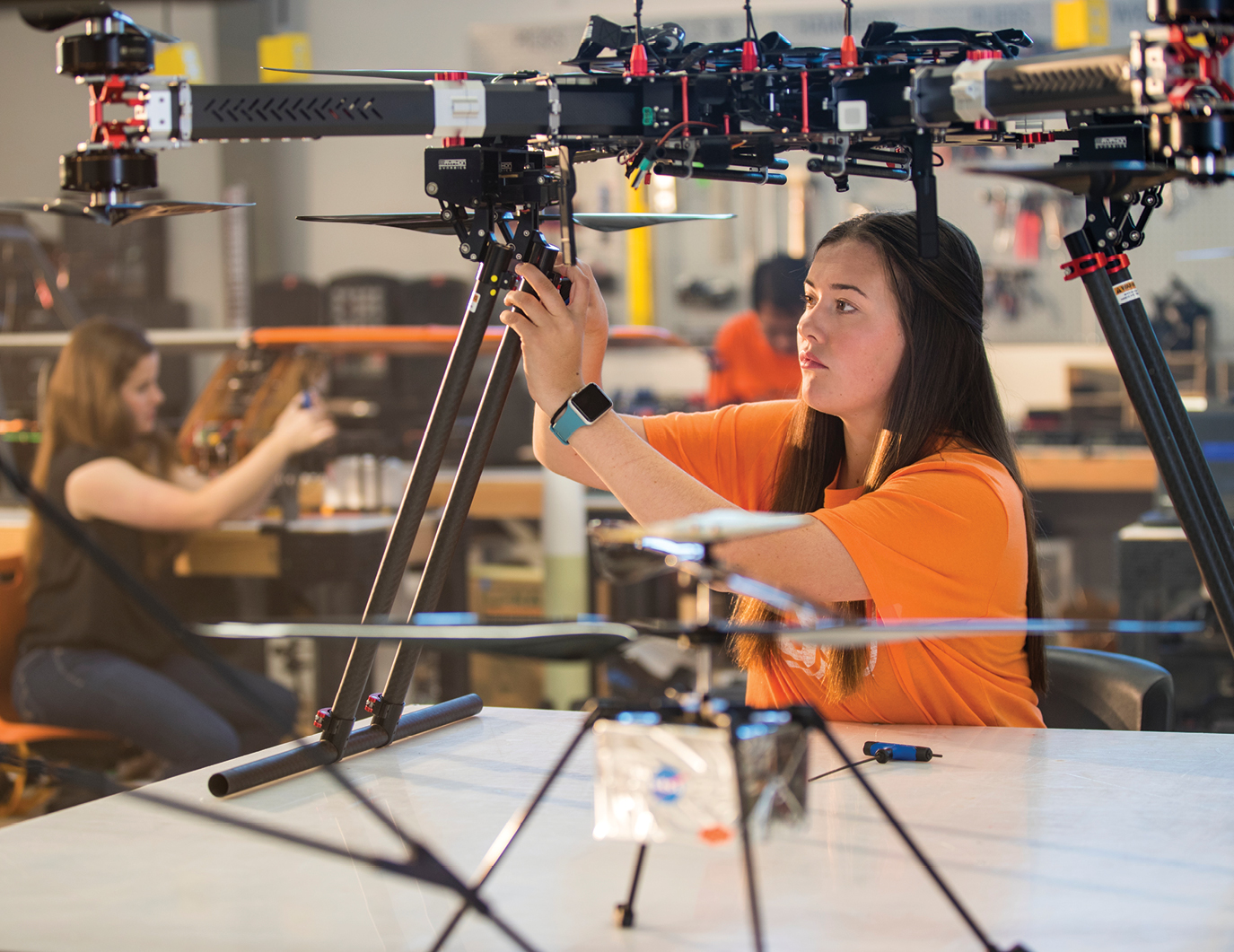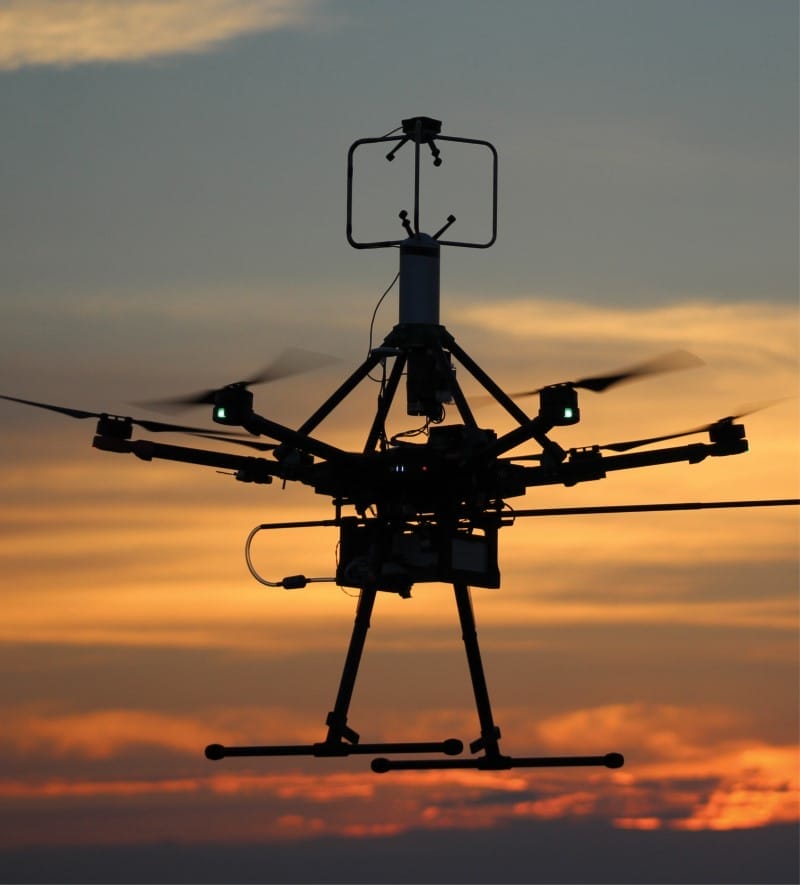The multi-pronged force of partners pushing to reboot Tulsa’s manufacturing core is refreshingly candid about the urgency of their task yet jazzed about the initial returns on what is a far-flung project.
Tulsa, whose existing manufacturing base in energy and aviation has experienced erosion, is one of scores of communities leveraging federal grants under the $1.9 trillion Build Back Better American Rescue Plan, approved in 2021. Tulsa will use the money it’s been awarded to help reset and reposition its backbone industries.
“Recognizing that we have an amazing legacy and an amazing industry base,” says Jennifer Hankins, chief of strategic partnerships for Tulsa Innovation Labs and federally designated coordinator of the grant, “the window is closing for us to really take that next step, that next leap towards something new. ‘Now or never’ is really the feeling that we have here.”
“Now” may have arrived last September, when Tulsa’s TRAM (Tulsa Regional Advanced Mobility) Corridor, a coalition of government, nonprofit, academic and private-sector partners, was one of 21 nationwide applicants awarded Build Back Better Challenge grants totaling $1 billion. In its winning submission, the TRAM coalition outlined a vision of a “super region” for advanced, uncrewed transportation systems supported by R&D, production and test capabilities. The coalition predicts the initiative will create 30,000-40,000 jobs within three years; several thousand are on the way already.
“We’re trying to be a one-stop shop for this industry and have carved out a real capability to do that,” says Hankins.
Among four projects funded under the TRAM Corridor’s $38.2 million award, the largest supports the construction of a wastewater treatment facility at Tulsa’s Port of Inola. As mundane as water treatment may sound — and as tangential as it would seem to advanced mobility — getting the project green-lighted was fundamental to what followed eight months later: namely, the biggest economic development deal in Oklahoma history, a solar energy investment that also serves to underscore how economic development rarely marches in a straight line.
The New Corridor Lands a Big One
In late May, Enel North America, through its affiliate 3SUN USA, announced plans to build a $1 billion solar panel manufacturing facility on up to 400 acres at the 2,500-acre Inola Port and within a half-mile of the planned $70 million water treatment facility. The factory’s expected annual production capacity of 3 GW and its projected creation of 1,000 jobs could nearly double under a possible second phase. Oklahoma, according to an official connected to the recruitment, beat out prospective locations in at least two other states. The Oklahoma Legislature approved a $180 million incentive package to help push the deal across the finish line.
“Our selection of Oklahoma is a testament to the strength of the Tulsa Port of Inola site, the state’s commitment to workforce development and an attractive investment climate,” said Giovanni Bertolino, head of 3Sun USA.
Officials connected to the TRAM Corridor — a coalition that includes Tulsa Innovation Labs, the Indian Nations Council of Governments, Tulsa Ports, Oklahoma State University, Partner Tulsa, The Tulsa Regional Chamber, the Osage Nation and the George Kaiser Family Foundation— believe beyond doubt that the Enel project would not have happened were it not for the green light given to the wastewater facility, which is supported by $22.3 million under the Corridor’s BBB Challenge grant.
“It’s one of the most sought-after requirements for all the major projects you see these days,” says Andrew Ralston, director of economic development for Tulsa Ports. “Every battery project, every hydrogen project, every solar panel project needs large capacities of wastewater and sewer water.”
Adhering to the spirit of a federal grant awarded under the heading of “advanced mobility,” Tulsa Ports, Ralston tells Site Selection, has “kind of a percentage goal” of recruiting projects uniquely devoted to crewless transportation to the Inola Port’s industrial park.
“But it’s important,” he says, “that we leave the park open for other priorities that need heavy capacities, heavy transportation assets and large tracts of land. Renewable energy is one of those industries we’re looking to attract. Enel will catalyze further development, so that we can continue recruiting other industries, which include those inside the Build Back Better goal of advanced mobility.”
An Ecosystem Begins to Take Shape
The first such recruit to the TRAM Corridor stepped forward in April. WindShape, a Swiss drone company, announced plans to build a testing and validation facility at Tulsa’s Skyway36 Droneport, a converted civilian airport just three miles north of downtown Tulsa. Owned by the Osage Nation and managed and marketed since November by Oklahoma City-based DronePort Network, Skyway 36 features a 3,000-ft. runway and a 40-acre light industrial park where WindShape is setting up shop.
“WindShape,” said CEO Guillaume Catry, “believes that Tulsa will become a major innovation hub and technology influencer in the emerging uncrewed aircraft and Advanced Aerial Mobility industry.”
WindShape’s planned 19,000-sq.-ft. facility is to include the capacity to simulate natural wind and weather profiles using, the company said in a release, its “Windshaper” technology.
“The new Windshape facility is a unique and much needed resource for the nascent Advanced Aerial Mobility sector,” says Dr. Jamey Jacob, director of the Oklahoma Aerospace Institute for Research and Education at Oklahoma State University.
Jacob is among those leading the development of a drone test bed, a Beyond Visual Line of Sight (BVLoS) commercial flight corridor anchored by Skyway 36 Droneport and supported by the BBB award. The test space is to extend 114 nautical miles across the 2,300-sq.-mile Skyway Range, another component of the TRAM Corridor vision. The sheer size of the Skyway Range — a key attraction to drone developers — is enabled in large part by the Osage Nation being sole landowner.
“It’s lots of open space, so it’s a very low-risk use-case scenario,” Jacob says. “But what makes it unique is that it connects to the suburban areas of Tulsa.”
That bifurcated landscape, Jacob explains, allows for higher-risk testing over rural expanses while also offering developers the option to “push the envelope” and demonstrate more advanced technologies over populated areas.
“It can be a testing ground for the ‘last-mile’ problem of drone delivery,” he says, “getting the product to the end user. That’s what makes it really special.”
Those Drones Are Coming, Really
Jacob also serves as director for the emerging LaunchPad Center of Advanced Mobility, touted by the TRAM coalition as a catalyst for developing new drone technologies, including such exotics as urban air mobility, otherwise known as urban air taxis. Jacob describes LaunchPad, funded by some $8 million from the BBB grant and embedded within the Helmerich Research Center at OSU-Tulsa, as a collaborative co-anchor with Skyway 36, one devoted to R&D and the other to testing. WindShape, says Jacob, will have a presence at both facilities.
“It could be an early-stage startup or a fully formed company,” he says of the types of businesses LaunchPad hopes to nurture. Support, he says, can range from technical expertise to business development coaching.
“Maybe they don’t have the research and development capability to build a prototype. We’re here to help them do that. Or maybe they’re lacking access to venture capital to get their company off the ground. And that’s where some of our partners come in, such as Tulsa Innovation Lab and the George Kaiser Family Foundation. The real goal here is to help energize these young companies to be able to get them off the ground.”
Jacob sees advanced mobility moving more swiftly out of the lab and into the real world, beginning — but not ending — with retail drone delivery.
“You place an order on your phone and get something delivered by drone within five to 10 minutes. We’ll start to see these rolled out on much larger scales over the next two to five years.”
Later down the line, he believes, are “drones large enough to carry people, where you really have that ‘Jetsons’ platform that will respond to your phone, land nearby and get you safely to your destination in five or 10 minutes. There’s a lot of work,” he concedes, “that still has to be done to make sure that can happen.”

OSU-Tulsa will house the LaunchPad Center of Advanced Mobility.
Photo courtesy of Oklahoma State University
True to Tulsa
A fourth program supported by Tulsa’s federal grant is to fund certificate programs, degree programs and apprenticeships to generate the workforce to help fill those thousands of projected jobs. Equitable economic growth being a cornerstone of the BBB Challenge, a commitment to inclusion is built into all four components of the TRAM Corridor project, says Jennifer Hankins of Tulsa Innovation Labs.
“In workforce,” she says, “we forecast that just over 50% of the jobs we create will be accessible without a four-year degree. That’s huge.” Average projected wages of nearly $70,000 a year, Hankins says, work out to one-third higher than the Tulsa region’s current average.
“Being a pretty small place,” she says, “we know that to be globally competitive in these emerging industries we have to be able to involve and engage everybody. We need more people in our workforce. We have to be focused on building from the grassroots up. It’s not just the right thing to do, but if we don’t figure out how to do it, our community won’t continue to grow.
“The Build Back Better win,” she says, “was huge. It funded not only our vision for advanced mobility but also our engagement with communities that haven’t been involved in high-tech endeavors.”
Most importantly, says Hankins, the boost from the Biden Administration “really pushes our legacy aerospace industry into the future. That’s who brought us to the dance. To build something entirely new would take us another handful of decades, so this opportunity is everything to us. It’s indicative of what we can do with what we have. It’s new, but it’s authentic to our region and it’s doable. We’re pretty excited.”

